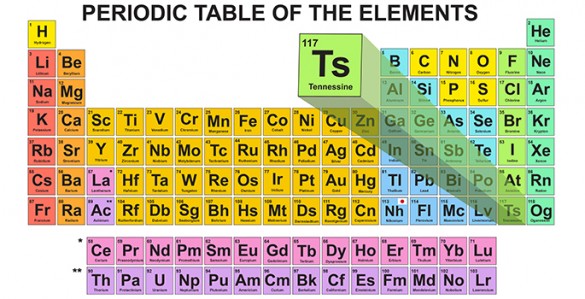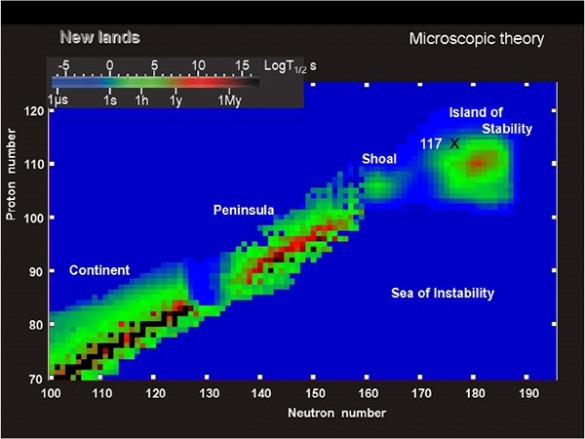

Among the provisional names of the new elements recently added to the periodic table announced today by the International Union of Pure and Applied Chemistry (IUPAC) is “tennessine,” which was chosen to honor of the state of Tennessee where members of the international collaboration that made the discoveries – Vanderbilt University and Oak Ridge National Laboratory (ORNL), later joined by the University of Tennessee (UT) in Knoxville – are located. The collaboration also included the Flerov Laboratory for Nuclear Reactions (FLNR) in Russia and Lawrence Livermore National Laboratory (LLNL) in California.
The name tennessine was proposed by Joseph Hamilton, Landon C. Garland Distinguished Professor of Physics at Vanderbilt, and was adopted by the members of the Russian-American collaboration. Hamilton and Professor of Physics A.V. Ramayya at Vanderbilt played key roles in the discovery of element 117.

The four new elements with atomic numbers 113, 115, 117 and 118 fill in the bottom row of the periodic table. Element 113 was discovered by a Japanese research group while the Russian-American collaboration discovered 115, 117 and 118. Tennessine (Ts) is the provisional name for element 117. The provisional name moscovium (Mc) was chosen for 115 to honor the historic name of the region where the Russian laboratory is located and the provisional name oganesson (Og) was chosen for 118 to honor the contributions of Academician Yuri Oganessian of FLNR who headed the collaboration. The “ine” ending on tennessine reflects that fact that the element falls in the halogen chemical family made up of fluorine, chlorine and bromine and so is expected to have similar chemical properties.
“Formal certification of these provisional names is expected in five months,” Hamilton said. “After this occurs, the name of the state of Tennessee will be in the periodic table in textbooks of physics and chemistry worldwide forever.” At that point, Tennessee will become only the second U.S. state to have an element named after it. Californium, element 98, was discovered in the 1950’s and was named after the university and state of California. (Hassium, element 108, was discovered in 1984 and named after the German state of Hesse.)

The discoveries of these new elements were carried out in Russia by a collaboration of the Flerov Laboratory for Nuclear Reactions in Russia, Oak Ridge National Laboratory, Vanderbilt University and Lawrence Livermore National Laboratory. Actinide targets produced in ORNL’s High Flux Isotope Reactor were transported to Russia and bombarded with calcium-48 in “hot fusion” reactions to form the three new elements. Scientists from the four institutions carried out the experiments under the leadership of Yuri Oganessian, the head of the Russian group.
This major international collaboration of U.S. and Russian laboratories made the discoveries possible. The new elements complete the seventh row of the periodic table and most importantly provide evidence for the long sought, theoretically predicted “island of stability,” The concept of an “island of stability” was first proposed in the 1960’s. Increased stabilities, with much slower rates of decay, were predicted for super heavy elements with much higher numbers of neutrons (N = 184) and protons (Z ≥ 112) than those previously known.

“The new nuclei produced in this research have substantially increased lifetimes consistent with landing on the shores of the island,” said Hamilton. “These discoveries – evidence for the island’s existence and the new elements themselves – represent a major advance in our understanding of the behavior of nuclear matter under the extreme stress of the ultra-large electrical forces that exist between the high numbers of protons that are packed into these new nuclei.”
Hamilton, Ramayya and Oganessian began collaborations on nuclear structure research around 1990 and have published over 250 research publications together.